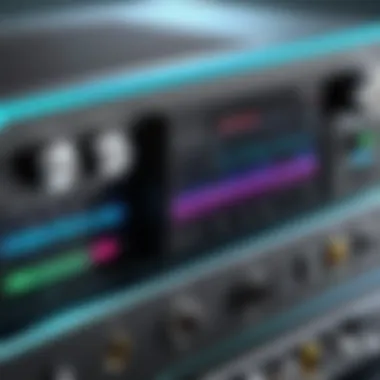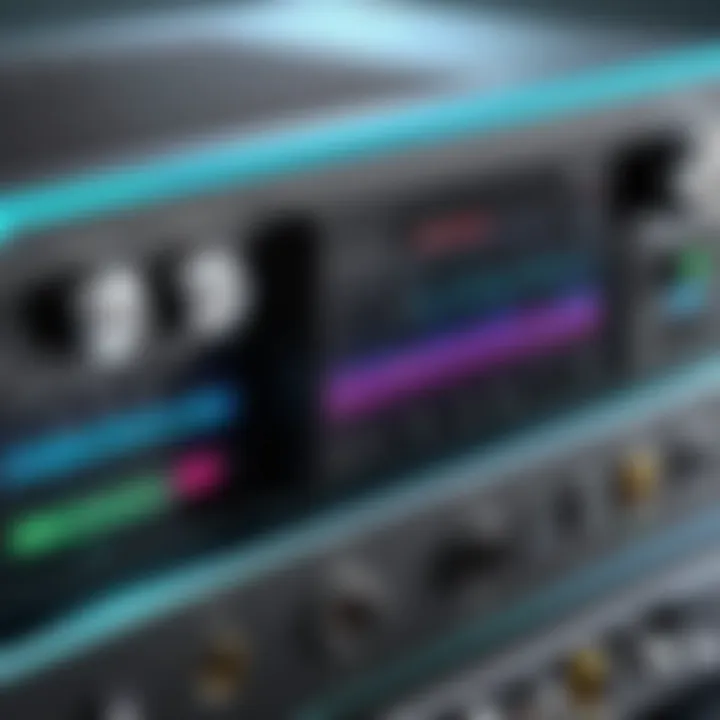Extract Audio from Video on Android: A Complete Guide


Overview of Topic
When it comes down to mobile technology, the need to extract audio from video files on Android devices is surprisingly common. Whether it's for creating remixes, saving a favorite clip for easy listening, or even for educational purposes, understanding the ins and outs of this process is invaluable. Many users find themselves in situations where they want just the audio part of a video. This need has led to various methods and tools designed specifically for audio extraction, making it a noteworthy topic.
Historically, as smartphones became multifunctional tools, users began to seek more personalized ways to manage their media. What started as simple video recording and playback capabilities has evolved into a robust ecosystem where multimedia content can be expertly manipulated. The rise of content creators and the demand for different media formats paved the way for applications that extract audio seamlessly.
Fundamentals Explained
To grasp the process of saving audio from video, it's important to familiarize oneself with several key concepts and terminology:
- Audio Extraction: The process of isolating the audio track from a video file.
- Codec: A software or hardware tool that encodes or decodes media content, impacting quality and file size.
- Container Format: The type of file that holds multiple types of data, including audio and video. Common formats include MP4 and MKV.
Understanding these terms will serve as a solid foundation for anyone looking to delve into audio extraction.
Practical Applications and Examples
So, how can one go about extracting audio? There are practical applications in both personal and professional realms. Here are a few scenarios and tools:
- Music Remixes: Fans often edit music videos to create new versions of their favorite tracks. Utilization of apps like VidMate can simplify this process.
- Educational Uses: Teachers may wish to extract audio lectures from video recordings for students, making them available on various platforms.
Hands-on Example
Using an app like Audacity (for desktop but an example of possible software use), one could import a video file and export the audio as an MP3. Though this would be different on Android, it demonstrates how cross-functional tools can be employed in audio extraction methods.
Advanced Topics and Latest Trends
Looking forward, there are advancing technologies that make audio extraction more efficient. For instance, there is an increasing integration of AI that can enhance audio quality while preserving the original content’s essence. As user videos become richer in content, adaptive bitrate streaming helps in selecting quality based on user bandwidth, allowing for better experiences during extraction.
Mobile applications are also starting to harness machine learning. Imagine an app that learns your preferences for audio quality or format, streamlining the extraction experience even further.
Tips and Resources for Further Learning
To further this understanding, here are several resources worth exploring:
- Books: "Audio Editing for Dummies" offers insights into audio editing that can be applied to extraction as well.
- Online Courses: Websites like Coursera and Udemy have courses focusing on audio management.
- Tools:
- Video to Audio Converter
- MP3 Video Converter
"Embracing the right tools can transform a daunting task into a simple process."
With each of these resources, users can empower themselves to navigate the audio extraction landscape confidently, reinforcing that knowledge paired with practical skills creates a dynamic learning experience.
Understanding Audio Extraction
Audio extraction stands as a crucial skill for anyone interacting with multimedia content on their devices. Imagine you've stumbled upon a lively video; perhaps it features a musical performance or an insightful interview, but you only need the audio. This is where audio extraction comes into play. It allows users to salvage those audio gems from videos, catering to both personal enjoyment and professional use.
Definition and Relevance
At its core, audio extraction refers to the process of separating audio tracks from video files. This can mean all sorts of things – from pulling a catchy tune from a vlog to isolating spoken dialogue from a lecture. The relevance here cannot be overstated, particularly in our digital world where content is churned out in various formats daily. Given the continuous evolution of Android devices and applications, understanding how to effectively extract audio enables users to make the most out of their media consumption and production.
Common Use Cases
The act of extracting audio might seem niche at first glance, but it's more versatile than you'd think. Here are some common scenarios:
- Creating Playlists: Extracting audio from video clips allows users to assemble their own playlists or mix tapes featuring favorite tracks or speeches.
- Podcast Production: Many podcasters find value in utilizing snippets from video interviews to enrich their audio content, often creating engaging episodes from discussions with guests.
- Educational Purposes: Students may extract audio from educational videos for easier digestion of content. Listening can often aid in retention much more than reading alone.
- Archiving Sound Bytes: Documentarians or researchers might need to save specific audio segments for future reference, making the process essential when referencing various speeches, interviews, or ambient sounds.
By becoming proficient in audio extraction, users can unlock the potential of their video libraries, transforming them into rich auditory resources for various uses.
Native Android Features
When it comes to saving audio from video files, the first place to look is within the default functionalities offered by your Android device. Native Android features often provide surprisingly robust tools that many users overlook. Here, we dive into the importance of leveraging these built-in capabilities, which not only minimize the need for extra apps but also enhance the overall user experience.
Benefits of Using Native Features:
Using native Android features can often result in quicker and more reliable audio extraction. With these tools, you won't have to worry about compatibility issues that sometimes arise with third-party apps. Also, since they are embedded within the operating system, their performance is generally optimized for the device. This leads to better battery consumption and overall efficiency. As Android updates continually roll out, these features often get more refined, providing improved performance and additional options over time.
Considerations:
Not all Android devices come with the same app configurations. Depending on the Android version, functionalities may vary. Users with more recent updates may have access to advanced features like built-in screen recorders, while those with older versions may find their options more limited. Thus, it is crucial to know your device's capabilities and adapt accordingly.


Using Screen Recorder
Screen recording has become a standard function in many Android devices. This feature allows you to capture both video and audio simultaneously. Here’s how to go about it:
- Access the Screen Recorder:
Depending on your version and brand, you can find the screen recorder in the quick settings menu or the applications drawer. - Start Recording:
Open the video you wish to extract audio from, tap the screen recorder, and start your recording. Make sure to adjust the audio settings to include internal audio if your device supports it. - Stop and Save:
Once you finish, stop the recording. The audio extracted will be saved in your device’s gallery or the specified storage location.
Using this method, you can often achieve satisfactory quality without the hassle of additional apps.
Extracting Audio from Screenshots
This technique might sound odd initially but stick with me. Some devices allow you to extract audio from video files through the automatic generation of audio clips from screenshotted content. The integration of tools like Google Photos makes this process seamless:
- Take a screenshot of the video you are interested in.
This can usually be done by pressing the volume down and power button together. - Open Google Photos:
Navigate to the screenshot you just took. Some devices might directly link this to audio extraction functionalities. - Extract Audio:
Use the editing tools provided within Google Photos or similar apps to isolate and extract audio clips from the video portion represented in the screenshot.
Although this may seem less direct than conventional methods, it illustrates yet another angle of how native Android features can serve multiple functions, aiding in creativity as well as practical needs.
Native features not only ease the process of audio extraction but also reduce dependency on third-party tools that may complicate matters.
Choosing the Right App
Choosing the right app to extract audio from video on Android is akin to finding the right tool for the job. With so many options available, a discerning user needs to evaluate various aspects to ensure efficient extraction without compromising quality. This decision can significantly affect the user experience and the resultant audio files.
When selecting an audio extraction app, one should first consider the specific features each application offers. Different apps cater to different needs; some may provide a wider variety of supported formats, while others might excel in speed or quality of the output. It's crucial to recognize what you need. For instance, if you intend to maintain the original audio quality, look for applications that offer lossless extraction. Some apps focus mainly on convenience, allowing for quick extractions with minimal fuss, while others provide comprehensive editing tools to refine the audio post-extraction.
The user interface is another critical element. An intuitive interface can make a world of difference, especially for those who might not be particularly tech-savvy. If the app's interface feels cluttered or overly complicated, it could lead to frustration and mistakes during the extraction process. A clean, simple layout with clear instructions often yields better results and a smoother experience.
Moreover, the reputation of the app in the user community can’t be overlooked. Reviews can offer insights into any persistent bugs or issues others have faced, which can help steer clear of potential headaches. It's worth noting that very popular apps may receive regular updates, improving their functionality over time.
Evaluating Features
To effectively choose an app, evaluating its features is paramount. Key aspects to analyze include:
- Output Formats: Does the app support common formats like MP3, WAV, and AAC? If you have specific preferences, ensure the app accommodates those.
- Editing Capabilities: Some apps allow editing of audio tracks after extraction, letting you trim, merge, or adjust tracks. If post-processing is a priority for you, look for these capabilities.
- Batch Processing: For users needing to extract audio from multiple videos, batch processing can save a great deal of time. Check if the app supports this feature.
- Audio Quality Settings: The option to adjust bitrate and sample rate can be essential, especially for audiophiles concerned about end quality.
Each of these elements contributes to how well the app performs its task. A one-size-fits-all approach rarely applies, hence, always take the time to assess what features align most closely with your needs.
User Interface Considerations
User interface can make or break your experience with the app. A good interface is not just about the looks; it’s about functionality and ease of use. Here’s what to look for:
- Clean Layout: An uncluttered workspace can help you focus on the task at hand without distraction. Avoid apps where tools and options are jumbled together.
- Logical Navigation: An interface that follows a sensible logic stream ensures that users can easily navigate through different settings and functionalities. You should feel comfortable maneuvering between import, extraction, and export options.
- Help and Tutorials: Some apps offer guided setups or tutorials, which can be a real boon for those new to audio extraction. Check if the app provides guidance on usage to avoid missteps.
In summary, the right app goes beyond aesthetics; it’s about functionality tailored to users' needs. Taking time to assess the features and usability can lead to a significantly improved audio extraction experience.
Popular Apps for Audio Extraction
When it comes to extracting audio from videos on Android devices, the available apps play a critical role. The right tool can make all the difference, not just in terms of functionality but also in user experience. There are a plethora of apps that cater to this need, each boasting unique features, usability, and output quality. Understanding these apps helps users make informed choices based on their specific requirements. With these tools, users can easily convert video soundtracks into separate audio files, turning their favorite videos into playlists or extracting voiceovers for various projects. The main benefits of using these apps include ease of use, diverse formats for export, and additional editing options.
Audio Extractor Pro
Audio Extractor Pro is a staple in the realm of audio extraction applications. Users appreciate its straightforward interface, making it accessible for anyone, regardless of technical know-how. The app allows users to pull audio from different video formats like MP4, AVI, and MKV, which is quite handy. The extraction process is relatively simple: just choose your video file, tap extract, and you’re good to go. One noteworthy benefit is the ability to choose various audio formats like MP3 or WAV, catering to different user needs.
However, some variants of this app may come with ads, which can interrupt the process. If you're looking for a feature-rich but easy-to-navigate app, Audio Extractor Pro is worth considering.
VidTrim
Next on the list is VidTrim, another popular choice among users. This app not only extracts audio but also provides video editing capabilities, making it doubly useful. If someone intends to edit video clips before extracting audio, this app can be a one-stop shop. Users can trim videos, apply effects, and extract only the portion of audio needed without fuss.
One of the standout features of VidTrim is its ability to share files directly with social media platforms. This convenience cannot be understated in a world where users increasingly value quick sharing options. VidTrim does present some restrictions in its free version, pushing users to consider an upgrade for additional features.
Timbre
Timbre is another heavy-hitter in this category. What sets Timbre apart from its competitors is its rich feature set tailored specifically for audio manipulations. Besides extracting audio, it allows users to merge audio files, cut, and even change pitch. If your needs extend beyond mere extraction, Timbre offers functionalities that are both powerful and user-friendly.
The interface is sleek, and the operation flow is intuitive, reducing the learning curve typically seen with similar apps. Users have remarked favorably about sound quality, although it might depend on the original video quality. With this app, combining audio from various sources becomes a breeze.


Lexis Audio Editor
Finally, we have Lexis Audio Editor, which leans more towards audio editing than simple extraction. This app supports multiple formats and serves as a solid audio editing tool. It's ideal for users who want to not just extract audio but also modify it afterward.
With features like record, import, and export capabilities, Lexis can also manage audio effects, providing users with a broader scope of creative potential. Users often point out how well the app performs, even on lower-end devices. Some features, such as advanced editing tools, might require a purchase but offer high value for those in need of a more comprehensive solution.
"Choosing the right app for audio extraction can lead to a smoother experience and improved results in your audio projects. The options are abundant—it's all about finding what fits your needs best!"
In summary, selecting the right tool is pivotal in ensuring a successful audio extraction process on Android. With each app offering distinct advantages, it's crucial for users to align their needs with the app's capabilities. This careful consideration can save time and yield much better results.
Step-by-Step Audio Extraction Process
The process of extracting audio from a video file on Android is not just a mere task; it can be crucial for various users. Whether you want to save a podcast from a video, extract a song from a music video, or simply want to convert lecture material into audio for easier consumption, understanding how to carry out this operation is essential. Delving into the nuances of this step-by-step audio extraction process ensures that you approach the task systematically, maximizing both efficiency and audio quality. It also helps to circumvent common hurdles—allowing for a smoother user experience, which can't be stressed enough.
Installing Necessary Apps
Before you can start the extraction process, installing the right applications is fundamental. Many users overlook this phase, yet the effectiveness of the subsequent steps relies heavily on this foundation. When choosing an app, it might seem tempting to go for the first one that pops up on the Google Play Store. But take a moment to evaluate, as you want an app that balances user-friendliness with robust features.
- Search for reputable apps such as Audio Extractor Pro, VidTrim, or Timbre. Most of these tools are straightforward and have garnered positive feedback from users.
- After identifying your choices, proceed to download and install the selected app(s) by following the prompts.
- Ensure your device has enough memory—nothing worse than running out of space midway through a project!
Importing Video Files
With the app in hand, the next step is importing video files. This should be seamless in a well-designed app, but keep an eye out for nuances. Here’s how to do it effectively:
- Open the app and navigate to the import function, typically found on the home screen or in a menu.
- Select the video you wish to extract audio from. Make sure you're importing a compatible file format—video files come in various formats, and not all apps will support them. It’s wise to check the app documentation for supported formats.
- Confirm that the video is loaded correctly into the application. If it’s not displaying properly, there could be an issue with the file itself.
Selecting Audio Format
Once you have imported the video, the next pivotal step involves selecting the audio format. It’s not merely a cosmetic detail; the format you choose will determine the quality and compatibility of the audio file across different devices. Here’s what to consider:
- Common formats include MP3, AAC, and WAV. MP3 is prevalent due to its well-rounded balance between size and quality, making it suitable for most uses.
- Think about where you plan to use the audio file. For high-fidelity projects, WAV may be the better choice, but it also demands considerably more storage.
- Some apps allow you to set custom bitrates or sample rates, so if you’re on the tech-savvy side, take a moment to tweak those settings as desired.
Extracting Audio
The final stage is where the real magic happens: audio extraction itself. Once you’ve chosen the format, extracting audio is usually just a button press away. Here’s how you can make sure you do it right:
- Ensure all your settings are in order—this includes verifying the selected format and bitrate.
- Hit the extract button. The application will typically show a progress bar indicating how far along it is.
- Once completed, you’ll likely be prompted with options to play or save the new audio file. Save it in a location that’s easy for you to remember!
Remember, the quality of the extracted audio depends significantly on the original video file. If the video has good sound, the audio will reflect that.
In summary, the step-by-step audio extraction process on Android is integral for users needing versatility in audio formats. By going through the detailed measures of installing the right applications to the final extraction, you can ensure a superior output that meets your needs.
Audio Quality Considerations
When dealing with audio extraction from video files on Android, one cannot overlook the importance of audio quality considerations. The sound quality can significantly impact the listener's experience, whether it’s for personal enjoyment, professional use, or academic projects. Poor audio quality can create distractions, overshadow important content, and leave a bad impression.
Several factors play a role in determining audio quality during extraction. When grabbing sound from a video, users need to pay attention to specific elements, starting from the bitrate to the sample rate. These elements serve as the backbone of audio fidelity and play a vital role in preserving the clarity of sound. Ignoring these factors could be akin to trying to paint a masterpiece with a dirty brush; no matter how good the video content is, poor sound can undermine the whole effort.
"Quality is never an accident; it is always the result of intelligent effort."
Bitrate and Sample Rate
Bitrate and sample rate are two of the most significant aspects influencing audio quality.
- Bitrate refers to the amount of data processed in a given time period during audio playback, usually measured in kilobits per second (kbps). The higher the bitrate, the better the audio quality. For example, an audio file extracted at 320 kbps will typically sound clearer and more detailed than one at 128 kbps. However, a higher bitrate also means larger file sizes, which can be an issue if storage space is a concern.
- Sample rate, measured in kilohertz (kHz), dictates how many samples of sound are taken every second. A common sample rate for decent quality audio is 44.1 kHz, which is equivalent to the standard for CDs. Choosing a sample rate that is too low may result in a loss of high-frequency sounds, making the audio seem dull or lifeless.
Both bitrate and sample rate should be selected based on the intended use of the audio. For example, if you’re looking to share your work on a music platform, aiming for higher settings would be beneficial. If it’s just for personal use, more modest settings could work.
Maintaining Quality During Extraction
Maintaining quality during audio extraction is a crucial concern, one that often gets overshadowed by the excitement of the process itself. To ensure that the audio remains as faithful to the original track as possible, consider the following steps:
- Choose Quality Apps: Not all extraction apps are created equal. Opt for reputed applications that prioritize audio quality. Some apps might compress or alter the audio during extraction, which can degrade the final output. Look for tools specifically noted for preserving audio quality.
- Use Lossless Formats: When saving your audio files after extraction, consider using lossless formats such as WAV or FLAC. These file types maintain the original audio information without any loss, in contrast to more compressed formats like MP3 which can sacrifice quality for smaller file sizes.
- Avoid Filtering during Extraction: Some apps offer additional filters or settings designed to enhance the audio. While this may seem beneficial, it can sometimes lead to unforeseen issues. Stick to straightforward extraction, and make adjustments afterward if needed.
In summation, audio quality considerations play a pivotal role in the extraction process. Taking time to understand and apply the principles of bitrate, sample rate, and maintaining quality can make a world of difference. Users ought to be mindful of their choices so that the extracted audio not only sounds good but also does justice to the source material.


Troubleshooting Common Issues
When diving into audio extraction, it’s not just about knowing how to pull the audio out; it’s understanding the bumps along the road. Troubleshooting common issues is critical for keeping the process smooth and effective. If you're slogging through these technical challenges, it can be frustrating. Knowing how to nip problems in the bud can make the difference between a successful extraction and a wasted afternoon. Let’s break down the most typical headaches you might face.
Import Errors
Import errors can throw a wrench in your plans. This happens when the app or tool you’re using cannot recognize the video file you are trying to work with. Reasons can be varied; it might be the video format, file corruption, or something as minor as a misnamed file.
To start with, check the format of the video. Formats like .mp4 and .mov are almost universally accepted, while some apps can be picky.
Here are some tips to tackle import errors:
- Check Video Format: Ensure that your video is in a format your extraction tool can handle. If not, consider converting it.
- File Integrity: Corrupted video files can cause import issues. Use reliable video players to confirm the file plays correctly.
- App Permissions: Sometimes, the app may need permission to access your media files. Double-check the app settings in your device's settings menu.
If after all this it still won’t import, try another extraction app. Sometimes, it’s just the specific app that’s being difficult.
Audio Sync Problems
Audio sync problems can make an otherwise enjoyable extract feel like a chore. This is where your audio comes out of sync with the video, or it lags behind. Often, this can stem from varying frame rates in the original video.
Here are some strategies to overcome audio sync issues:
- Consistent Frame Rates: Check if the video is recorded at a consistent frame rate. If it flutters between different rates, that inconsistency may lead to sync issues.
- Use High-Quality Tools: Not all extraction tools are created equal. Using reputable apps can mitigate sync problems more effectively.
- Adjust Sync Manually: Some advanced editing tools allow you to adjust the audio manually. It’s a bit of a tedious task, but it can resolve the issue if needed.
In summary, troubleshooting is an essential aspect of the audio extraction process on Android. Understanding common issues, like import errors and audio sync problems, arms you with the knowledge to handle disruptions effectively. By following the outlined strategies, you can streamline your audio extraction and improve the overall experience.
Legal Considerations
When it comes to extracting audio from video files on Android, the legal side of things can get a little murky. Understanding the legal considerations surrounding this process is essential for anyone hoping to navigate the digital landscape responsibly. Ignoring these factors can lead to unintended consequences, including copyright infringement and legal disputes. Essentially, if you plan on using extracted audio for anything beyond personal enjoyment, it’s prudent to know the rules that apply.
Copyright Issues
Copyright issues are at the forefront of many legal discussions regarding audio extraction. The Copyright Act protects the original works of authorship, which include music, films, and other multimedia content. If you extract audio from a video that you do not own — say, a YouTube video or a film — you could be crossing legal boundaries.
In many cases, using someone else's material without permission is deemed as copyright infringement. This could result in takedown notices or even legal action against you. If you're considering extracting audio for commercial use, it becomes even more critical to tread carefully.
Here are some key points to keep in mind regarding copyright:
- Ownership: Always confirm who owns the audio content you want to extract. If it's not yours, it's best to get permission.
- Attribution: In some cases, giving credit may not be enough. You might still need explicit permission to use the audio.
- Platform Terms of Service: Various platforms have their own rules. Before using content from sites like YouTube or Vimeo, make sure to read their policies on content usage.
Fair Use Policies
Fair Use Policies are often discussed as a way to navigate the murky waters of copyright law. Under certain conditions, you may be able to use copyrighted material without seeking permission. However, fair use is not a blanket protection and must be evaluated on a case-by-case basis.
In its simplest form, fair use can apply in these scenarios:
- Educational Purposes: Using audio for educational or instructional content may qualify as fair use, especially in non-profit settings.
- Criticism or Commentary: If your use of the audio involves critique, commentary, or parody, this may fall under fair use.
- Transformative Uses: If you alter the original content significantly enough to create something new, you might also be covered under fair use.
"Always be cautious with fair use. It's better to err on the side of caution than to find yourself in a legal hot seat."
Bear in mind, however, that being able to claim fair use doesn't mean you won't face challenges. It's always essential to understand the specific circumstances and possibly consult a legal professional if you're unsure. Whether you're an IT professional or a student, being informed about these legal aspects is crucial when engaging in audio extraction from videos.
Future Trends
As we stride into an era defined by dynamic multimedia content consumption, the significance of understanding future trends in audio extraction from video cannot be overstated. The world is evolving to favor convenience and efficiency, especially for mobile users who often juggle multiple tasks. This section sheds light on several key elements that are shaping the future landscape of audio extraction technology on Android devices, where staying ahead of the curve means enabling seamless user experiences.
Advancements in Audio Extraction Technology
In recent years, audio extraction technology has seen notable advancements that enhance usability and overall performance. Innovations such as AI-driven algorithms are now at the forefront, enabling more accurate and faster audio extraction processes. These technologies can isolate soundtracks from video files with a remarkable level of precision, even in challenging environments where background noise is present.
- Machine Learning Integration: Some applications utilize machine learning models to understand user preferences and optimize extraction settings automatically. For instance, if a user frequently extracts audio from music videos, the app can auto-select the best bitrate and sample rate for those files, ensuring high-quality output without requiring manual adjustments.
- Cloud Processing: Another stride forward is the rise of cloud-based solutions. These allow users to upload video files, process audio extraction remotely, and download the output. This not only reduces the load on smartphone processors but also opens up possibilities for more complex editing tasks without draining battery life or using too much local storage.
- Real-Time Extraction: Advancements also include real-time extraction capabilities, which allow users to listen to audio while extracting it. This feature is particularly beneficial for editing pros who need instant feedback on their edits.
"Technology should feel like an extension of ourselves, making our tasks easier rather than complicated." - A common sentiment echoed by users navigating the digital space.
Emerging Tools and Features in Android
As smartphone manufacturers like Samsung, Google, and OnePlus continually enhance their devices, new features that support audio extraction are emerging. Recent updates in Android OS are making it easier than ever to work with audio and video files. These emerging tools significantly lower the technical barrier for users wanting to extract audio.
- Native Support: Android’s latest iterations feature built-in audio extraction capabilities that do not require third-party apps. This increases accessibility as users can directly save audio tracks from videos stored on their devices or cloud-based storages.
- Gesture Controls: Some Android apps are now incorporating gesture-based controls, allowing users to simply swipe or tap to extract audio or edit it. This intuitive interface makes it easier for non-tech-savvy individuals to navigate and utilize audio extraction functionalities.
- Integration with Other Apps: Furthermore, new tools are being built with integration features that allow seamless sharing between apps such as video editors, email, and social media platforms. Users can directly export audio from videos into their favorite editing tools or share them on platforms with ease.
In summary, the trends in audio extraction highlight a move towards greater efficiency, user-friendliness, and advanced functionality. As technology continues to evolve, users can expect a more robust set of tools and features that facilitate the extraction and manipulation of audio from video on their Android devices.







